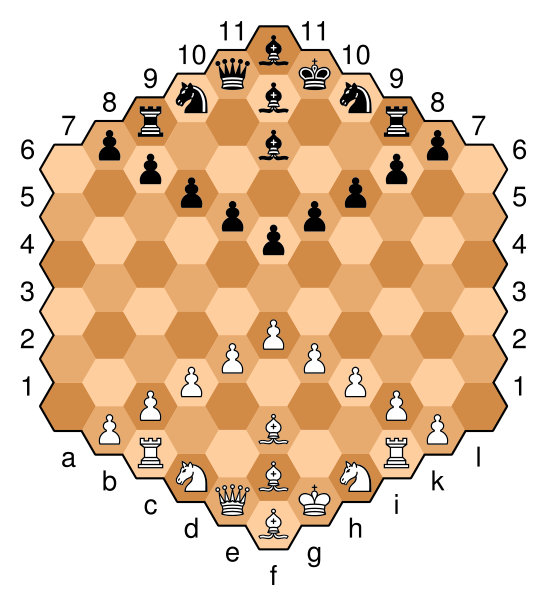Chess960 and Hexagonal Chess Variants
Short history of Chess960 and Hexagonal chess.



Throughout its long history, chess has inspired countless variations that challenge players to think beyond conventional patterns. Among these creative offshoots, Chess960 and hexagonal chess stand out for the fresh perspectives they bring to the game. One scrambles the starting position to break reliance on memorized openings, while the other redefines movement with a uniquely shaped board. By shifting the foundations of traditional play, these variants invite players to approach strategy in new and exciting ways—proving that even a centuries-old game can evolve without losing its essence.
Chess960 (Fischer Random Chess): Shuffling the Starting Lineup
Chess960, also known as Fischer Random Chess, was introduced by former world champion Bobby Fischer in 1996. Fischer’s goal was to eliminate the dominance of opening preparation and force players to rely on creativity and over-the-board skill. In Chess960 the board and pieces are the same as standard chess, but the starting position of the pieces on the back rank is randomized into one of 960 possible configurations (hence the name). Both White and Black get the same randomized setup (mirrored for black), and a few constraints ensure it remains a fair chess position – for instance, each side’s bishops must start on opposite-color squares and the king is placed between the rooks so that castling remains possible. Apart from this shuffled opening arrangement, all the normal rules of chess apply.
The impact on gameplay is immediate: with no fixed opening order, players cannot rely on memorized opening lines or book theory. Each game begins as a fresh tactical and strategic challenge, emphasizing “chess creativity and talent” over rote memory of openings. Early moves in Chess960 are often spent finding a harmonious piece development from the unusual layout, and both players must improvise from move one. This tends to sharpen a player’s understanding of fundamental chess principles (like pawn structure and piece activity) because there’s no familiar sequence to fall back on. Once past the opening phase, the game usually transforms into middlegame patterns that resemble normal chess – but those first unpredictable moves level the playing field and reward original thinking. Chess960 has gained a following for showcasing pure skill, and it’s even been officially embraced with events like the FIDE World Fischer Random Chess Championship. While Chess960 remixes chess within the traditional board, another modern variant is redefining how players experience the game by stepping into virtual worlds.
Hexagonal Chess: Six Directions of Strategy
Hexagonal chess is a variant that reshapes the board itself, using hexagon-shaped cells instead of squares. Dozens of hexagonal-board chess variants have been invented, but the most famous is Gliński’s hexagonal chess, created by Polish inventor Władysław Gliński in 1936. Launched commercially in 1949, Gliński’s game became “probably the most widely played of the hexagonal chess games” – it was especially popular in Eastern Europe, reportedly garnering over half a million players at its peak. Instead of an 8×8 grid, Gliński’s board is a large hexagon composed of 91 cells arranged in three alternating colors. The starting layout is roughly analogous to standard chess but spread across this hexagonal field. Each side still has a king, queen, knights, rooks, and bishops, but to fit the expanded geometry the armies are supplemented with an extra pawn (9 pawns per side) and a third bishop. The three bishops are necessary because of the board’s coloring: on a hex board, three cell colors exist (since three cells meet at each point), so you need three bishops to cover one color each. All these pieces arrange in a symmetric hexagonal formation at opposite ends of the board to begin the game.

The hexagonal board dramatically changes movement and strategy. Pieces now have up to six directions to move along (instead of four on a square grid), which alters their powers. A rook, for instance, can drive along straight lines of hexes in six different orientations (imagine moving along the spokes of a hexagon). A bishop moves along diagonal chains of hex cells, and a queen combines those abilities as in normal chess. Knights leap in an expanded L-shape that reaches new positions due to the hex coordinate system. Pawns move straight forward and capture on forward diagonals adapted to the hex layout. Notably, castling is typically absent in hexagonal chess, and even the concept of stalemate is handled differently in Gliński’s rules (it’s not an automatic draw but yields ¾ of a point to the stalemating player). These rule tweaks reflect the effort to balance the game on a larger board.
The net effect on gameplay is that hexagonal chess has a character all its own. The board’s extra scope creates broad, sweeping fronts – long-range pieces like bishops and rooks can form board-spanning networks of threat and control, covering huge swaths of the field. With more squares and directions, there are new tactical patterns: for example, two pawns side-by-side can shield each other in one move (due to the geometry), a maneuver impossible in orthodox chess. Coordinating three bishops (each stuck on its own color) is a fresh strategic puzzle, as they cannot cover for each other. Overall, players must rethink familiar ideas like controlling the center or planning pawn structures, since the “center” of a hex board is a different shape and flanking maneuvers take on new meaning. The game often has a more fluid, less congested feel because the 91-cell field gives pieces more room to maneuver. In short, hexagonal chess broadens chess into a new realm of possibilities, challenging even experienced players to adapt their strategy to a six-directional, honeycomb battlefield.
Conclusioin
From randomized setups to unconventional board shapes, these chess variants highlight the inventive spirit of the chess community in reshaping the game. Each one presents its own strategic twists: Chess960 challenges players to think creatively from the outset, while hexagonal chess reimagines movement and positioning with a radically different board design. Exploring these nontraditional formats allows players to rediscover the essence of chess through fresh perspectives. Despite the changing boards and rules, the timeless principles of the game—tactical insight, strategic depth, and imaginative problem-solving—continue to thrive, proving that the heart of chess remains vibrant across every variation.




